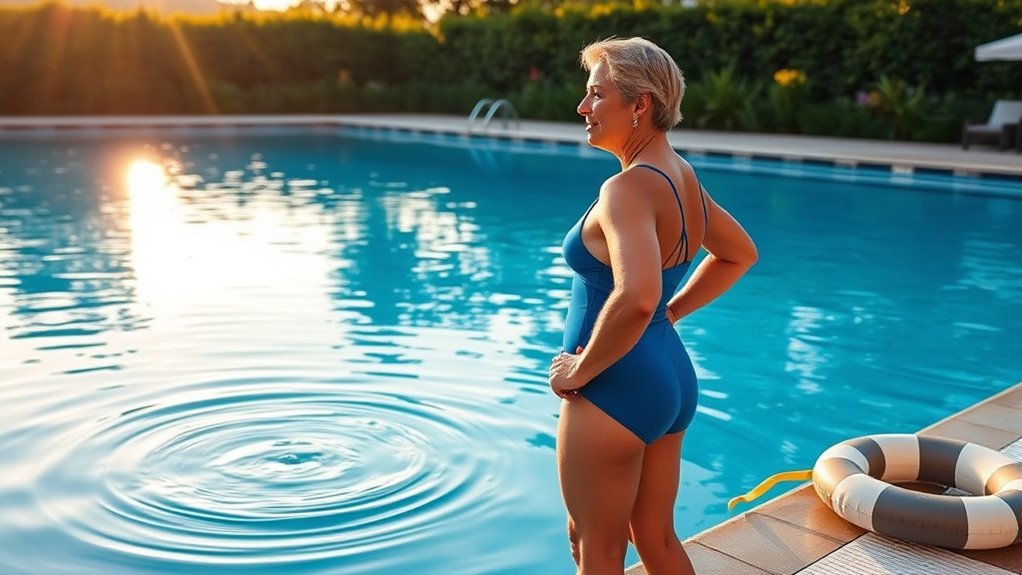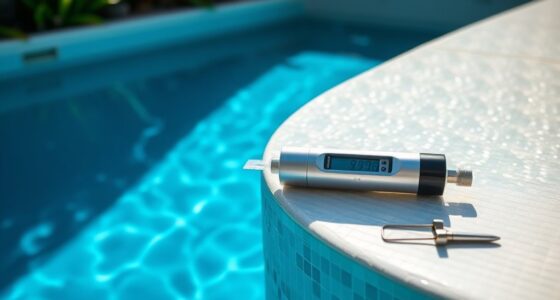To overcome your fear of water, start with gentle exposure in shallow areas and practice calm, steady breathing to reduce anxiety. Build confidence by celebrating small successes, like splashing or floating, and use positive self-talk to reframe your mindset. Gradually increase comfort with water through regular, patient practice and visualization techniques. If you’re curious about more strategies to feel safe and confident, keep exploring ways to transform your water fears into mastery.
Key Takeaways
- Practice slow, controlled breathing both on land and in water to reduce anxiety and promote relaxation.
- Gradually acclimate to water by starting with shallow activities like splashing and floating.
- Use positive self-talk and visualization to build confidence and reframe fears as manageable.
- Celebrate small successes consistently to reinforce progress and boost motivation.
- Work with patient instructors and employ gentle, step-by-step water exercises for steady confidence building.

Many people feel anxious or afraid of water, but with patience and the right approach, you can overcome this fear. The first step is to focus on breath control, which is vital for calming your nerves and building confidence. When you’re anxious, your breathing tends to become shallow and rapid, making you feel even more uneasy. Learning to breathe slowly and steadily can help you stay relaxed in the water. Practice simple breathing exercises on land—inhale deeply through your nose, hold for a few seconds, then exhale slowly through your mouth. As you become more comfortable, try to carry this controlled breathing into your water practice. It will help you stay calm, even when you’re in deeper or unfamiliar water. Incorporating AI-based feedback tools can also assist in monitoring your breathing patterns and progress, enhancing your learning experience.
Confidence building is fundamental to overcoming water fear. Start by familiarizing yourself with the water environment in a shallow, controlled setting. Stand in the pool, splash your face, and get used to the sensation of water on your skin. Gradually, try submerging your face and holding your breath, always respecting your comfort level. Celebrate small successes, like holding your breath for a few seconds or floating on your back. Each of these achievements boosts your confidence and reduces anxiety. Remember, progress might be gradual—don’t rush. Consistent practice, even for a few minutes each day, helps reinforce positive experiences and diminishes fear.
As you practice, focus on positive self-talk. Remind yourself that water isn’t dangerous, and that your fears are normal but manageable. Visualize yourself being calm and in control, which helps reframe your mindset. It’s also helpful to work with a calm, patient instructor or swimmer who can guide you through exercises tailored to your comfort level. They can teach you how to relax your body, which directly impacts your breath control and confidence.
Another effective technique is to practice gentle water activities outside of formal lessons, like walking in the shallow end or sitting on the pool steps. These activities help you acclimate gradually without feeling overwhelmed. Over time, your breath control improves, and your confidence grows. The key is to be patient, persistent, and kind to yourself. With each small step, you’re training your mind and body to feel safe in water, transforming fear into a sense of mastery and ease.
Frequently Asked Questions
How Long Does It Typically Take to Overcome Water Fear?
The time it takes to overcome water fear varies for each person. With consistent practice of breathing techniques and visualization exercises, you might see progress in a few weeks. Some may overcome their fear faster, while others need more time. Stay patient and persistent, and remember that small, regular steps build confidence. Celebrate your achievements along the way, and you’ll gradually feel more comfortable and in control in the water.
Are There Specific Mental Exercises to Reduce Water Anxiety?
Imagine revealing a hidden calm inside you—sounds intriguing, right? You can start by practicing breathing techniques to slow your mind and reduce anxiety. Visualization exercises also work wonders; picture yourself confidently in water, feeling safe and relaxed. These mental exercises build trust in yourself and diminish water anxiety, making your journey easier. Keep practicing regularly, and over time, you’ll notice your fear fading away, replaced by confidence.
Can Medication Help With Water-Related Phobias?
Medication can sometimes help with water-related phobias by reducing anxiety symptoms, but its effectiveness varies from person to person. You should consider consulting a mental health professional who can recommend appropriate options and provide support. Medication alone isn’t usually enough; combining it with therapy and mental health support often yields the best results in overcoming water fears. Always discuss potential benefits and side effects with a healthcare provider.
What Signs Indicate I Should Seek Professional Help?
Imagine your fear of water is a small fire; if it flickers but doesn’t grow, you can handle it with gradual exposure. But if you notice signs of panic—racing heart, trembling, or feeling overwhelmed—it’s time to seek professional help. Ignoring these signs can cause the fire to spread, making progress harder. A therapist can guide you safely through this process, ensuring your journey to water confidence stays on track.
Is It Possible to Learn Swimming Without Feeling Scared?
Yes, you can learn to swim without feeling scared by practicing breathing techniques and visualization exercises. These methods help calm your mind and build confidence in the water. Focus on slow, controlled breathing to ease anxiety, and visualize yourself swimming comfortably. With patience and regular practice, you’ll gradually overcome your fears and develop a positive, relaxed connection with water.
Conclusion
Remember, overcoming your fear of water is like learning to sail—at first, the waves may seem formidable, but with patience and practice, you’ll find your balance and glide smoothly. Each small step you take builds confidence, turning the vast, intimidating ocean into a welcoming pool of opportunity. Embrace the journey, enjoy each splash of progress, and soon you’ll be steering through water with ease. Immerse yourself with courage, and watch your fears drift away like clouds clearing from the sky.









